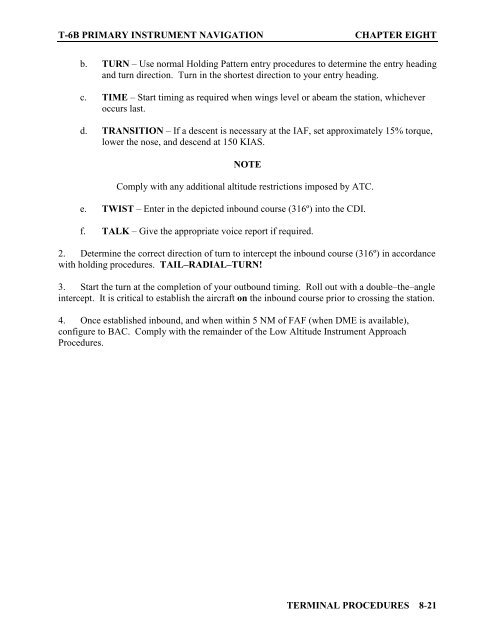Flight Training Instruction - Cnatra - U.S. Navy
Flight Training Instruction - Cnatra - U.S. Navy
Flight Training Instruction - Cnatra - U.S. Navy
You also want an ePaper? Increase the reach of your titles
YUMPU automatically turns print PDFs into web optimized ePapers that Google loves.
T-6B PRIMARY INSTRUMENT NAVIGATION CHAPTER EIGHT<br />
b. TURN – Use normal Holding Pattern entry procedures to determine the entry heading<br />
and turn direction. Turn in the shortest direction to your entry heading.<br />
c. TIME – Start timing as required when wings level or abeam the station, whichever<br />
occurs last.<br />
d. TRANSITION – If a descent is necessary at the IAF, set approximately 15% torque,<br />
lower the nose, and descend at 150 KIAS.<br />
NOTE<br />
Comply with any additional altitude restrictions imposed by ATC.<br />
e. TWIST – Enter in the depicted inbound course (316º) into the CDI.<br />
f. TALK – Give the appropriate voice report if required.<br />
2. Determine the correct direction of turn to intercept the inbound course (316º) in accordance<br />
with holding procedures. TAIL–RADIAL–TURN!<br />
3. Start the turn at the completion of your outbound timing. Roll out with a double–the–angle<br />
intercept. It is critical to establish the aircraft on the inbound course prior to crossing the station.<br />
4. Once established inbound, and when within 5 NM of FAF (when DME is available),<br />
configure to BAC. Comply with the remainder of the Low Altitude Instrument Approach<br />
Procedures.<br />
TERMINAL PROCEDURES 8-21
















